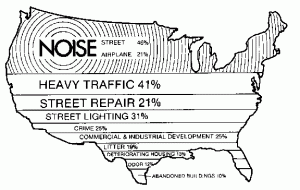
- Image via Wikipedia
Also discussed here: Noise Exposure and Public Health (9 page pdf, Environmental Health Perspectives, Vol 108, March 2000)
And here: Environmental Noise Control Guidelines (102 page pdf, City of Ottawa, 2006)

The handbook reviewed today describes a wide number of impacts of noise pollution ranging from cardiovascular health problems to learning difficulties for children. While air pollution is the cause of 8-10 % of premature deaths (in Canada), noise pollution causes hearing losses considered as a handicap for 13% of the population (in the USA).
Table of Contents:
- The National Noise Problem
- Hearing Loss
- Nonauditory Physiological Response
- Communication Interference
- Performance Interference
- Sleep Disturbance
- Subjective Response
- Community Response
- Health and Welfare Analysis
- Summary of Human Effects of Noise from Various Outdoor Noise Levels
“noise was a major neighborhood problem ..street noise was mentioned more often than all other unwanted neighborhood condition.. one-third of all the respondents who wished to move because of undesirable neighborhood conditions, did so because of noise”
“the day-night sound level of residential areas should not exceed 55 dB to protect against activity interference and annoyance..The threshold of pain is located at the upper boundary of audibility and in normal hearers is in the region of 135 dB for all frequencies.”
“13 percent of the U.S. population have hearing losses that can be described as handicapping”
“Hearing loss can:
- lead to reduced employability of the sufferer. It is especially damaging if children suffer hearing loss during their developmental and educational years.
- also be a safety hazard and can contribute to accidents because warning signals or calls for help can be missed by a person with a hearing loss
"the reading scores of children in grades two through five who live in an apartment building showed that the noise in and around the building was detrimental to their reading development. The longer the children had lived in the noisy environment, the lower their reading test scores”
Related articles by Zemanta
- Effects of Environmental Noise Pollution (generalmedicine.suite101.com)
- Noise pollution rattles nerves, harms health (seattletimes.nwsource.com)
- Measuring Urban Noise Pollution on the Decibel Scale (brighthub.com)
- Sound sleepers’ brain waves block noise (boston.com)
- Detrimental Effects from Anthropogenic Noise on Marine Life (brighthub.com)
- 4th of July Fireworks Pose Danger of Permanent Hearing Loss, Better Hearing Institute Warns (prweb.com)
- Millions Are Losing Their Hearing Unnecessarily; Noise-Induced Hearing Loss Is Often Permanent but Always Preventable, Says HearUSA Audiologist (prnewswire.com)

No comments:
Post a Comment